Among the many different species of Lavender, and one of the most interesting, is Lavandula stoechas subsp. luisieri (Rozeira) Rozeira, which is found only in Portugal and southwest Spain, and is often referred to as Seville Lavender. It is similar in appearance to other types of L. stoechas (butterfly Lavender, or Spanish Lavender), but Seville Lavender oil contains compounds that are not found in any other known plant.
Comparison with L. angustifolia oil suggests that Seville Lavender oil may possess more potent antibacterial and anti-inflammatory properties, and may be especially useful in tackling osteoarthritis and Alzheimer’s disease. There is no research on Seville Lavender and its action on the central nervous system, but the studies conducted to date do not suggest any notable toxicities for Seville Lavender oil when used at therapeutic doses (Arantes et al 2016; Videira et al 2013; Zuzarte et al 2012).
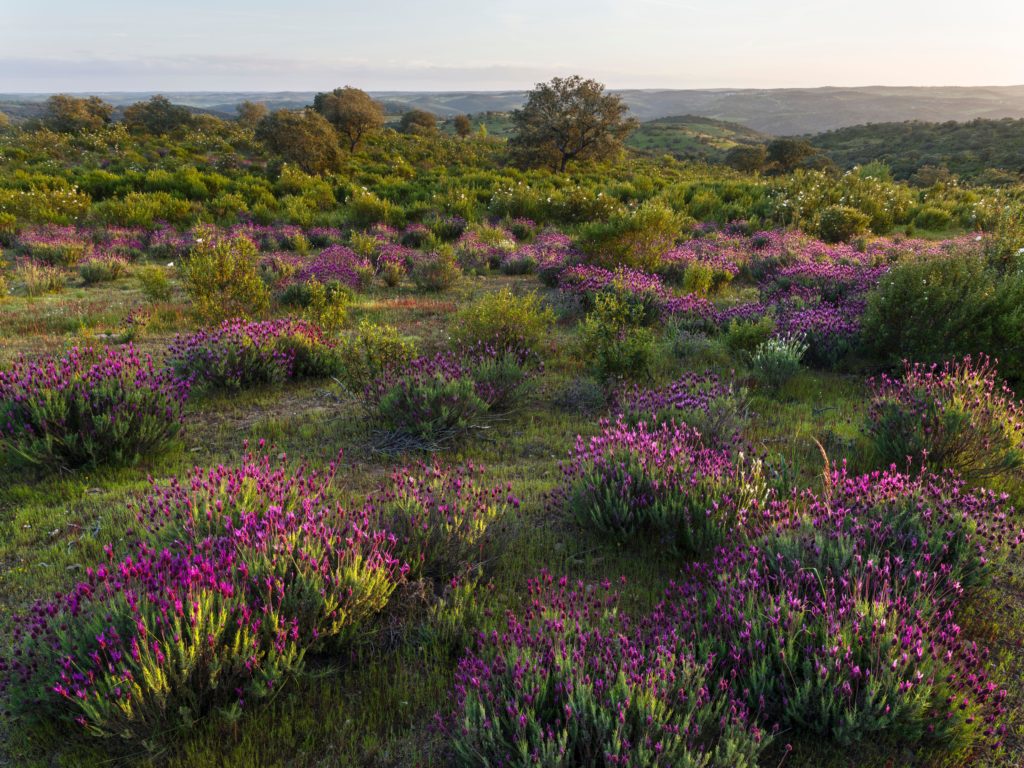
Wild growing L. stoechas in the nature reserve Parque Natural do Vale do Guadiana, Southern Portugal
Aroma
Seville Lavender oil smells nothing like regular Lavender oil, and is much more edgy. It has a potent sweet/resinous, dried fruit quality with hints of hay, leather and tobacco. There is also a dark green absolute, which is similar to the essential oil but is more intensely fruity.
Volatility
An important consideration concerns volatility. Due to its unique composition, Seville Lavender oil evaporates much more slowly than L. angustifolia oil. So whether used in surface cleaning, topically, by inhalation or by diffusion, the effects of Seville Lavender oil will almost certainly be maintained over a longer period of time than those of L. angustifolia oil. This also has obvious implications for fragrance composition.
Composition
The unique compounds found in Seville Lavender are based on a necrodane skeleton, and the most prevalent is trans-α-necrodyl acetate . This has been reported to occur from 2% to 55%, but most commonly at 15-20%. A direct comparison of some key constituents in Seville Lavender oil and L. angustifolia oil is shown below (Roller et al 2009). The percentages may not be absolutely typical of the commercially produced oils, but they do demonstrate the main differences in composition.
Seville Lavender oil reports with highly atypical composition, such as 60% camphor or 34% cineole are not included in this article.
Therapeutic properties
Insecticidal properties have been described for Seville Lavender oil, but are not covered here. Other properties that have been studied include: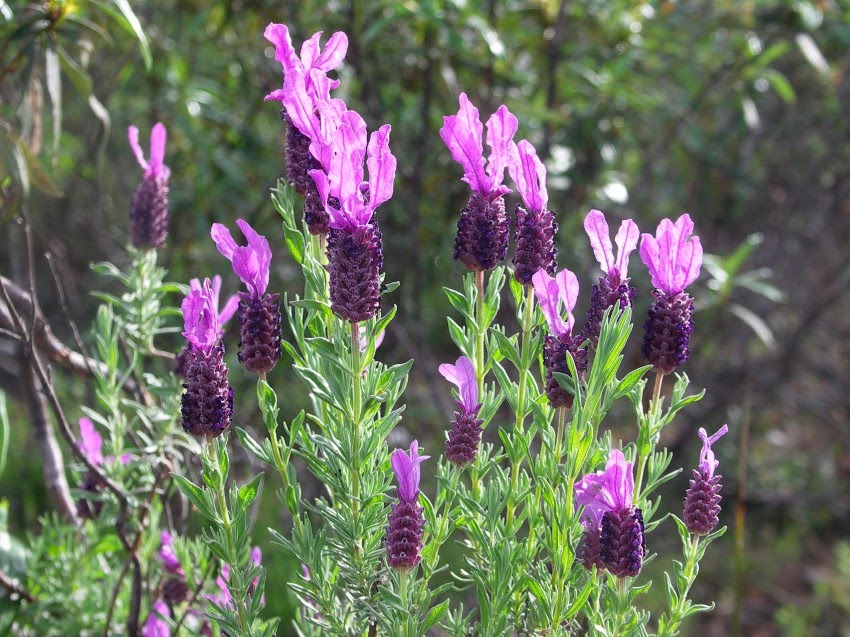
· Antibacterial
· Antifungal
· Analgesic
· Anti-inflammatory
· Antioxidant
· Anti-Alzheimer’s
Antibacterial
In a direct comparison of four Lavender oils and their in vitro antibacterial activity against methicillin-resistant Staphylococcus aureus (MRSA) and methicillin-sensitive Staphylococcus aureus (MSSA), Seville Lavender oil was slightly more potent against both strains, at all six concentrations tested.
Binary combinations of Seville Lavender with either L. stoechas or L. angustifolia were significantly more potent in antibacterial efficacy than the binary combination of L. stoechas and L. angustifolia, and they were also more potent than any of the individual essential oils tested (Roller et al 2009).
Other reports on Seville Lavender oil’s antibacterial activity include Arantes et al 2016, Baldovini et al 2005 and Pombal et al 2016.
Antifungal
Seville Lavender oil has demonstrated very good efficacy against a variety of pathogenic fungi, including several dermatophytes (Baldovini et al 2005; Baptista et al 2015; Zuzarte et al 2012). However, comparison with reports for L. angustifolia oil is difficult, due to different fungal strains being used, as well as different assessment parameters.
Analgesic
In a modified tail flick test in rats, Seville Lavender oil at 200 mg/kg s.c. demonstrated analgesic efficacy of 57% at 30 minutes, and 67% at 60 minutes. This was compared with morphine, which at the same time periods was 57% and 92% effective, though the dose (10 mg/kg s.c.) was 20 times less (Arantes et al 2016). Comparison with L. angustifolia oil is problematic as the same test has not been used, nor has any similar animal model. However, it is notable that Seville Lavender oil was as effective as morphine after 30 minutes at the doses used.
Anti-inflammatory
Rat paw edema induced by carrageenan is a standard test for anti-inflammatory activity. At an oral dose of 200 mg/kg, L. angustifolia oil inhibited rat paw edema by 48% (Hajhashemi et al 2003). In comparison, Seville Lavender oil at the same oral dose was almost twice as effective, with an inhibition of 83%, which was 14% more than the standard reference drug, dexamethasone (Arantes et al 2016).
In other research, Seville Lavender oil reduced the expression of a pro-inflammatory enzyme, iNOS (inducible nitric oxide synthase) by 55% and 81% in two different assays. (Rufino et al 2015). Taken together, these results suggest the probability of a therapeutic effect in osteoarthritis, and other types of musculo-skeletal inflammation.
Antioxidant
Four reports have assessed the antioxidant activity of Seville Lavender oil (Arantes et al 2016; Baptista et al 2015; Matos et al 2009; Pombal et al 2016). There are many ways to measure antioxidant activity, one of which is scavenging of the DPPH radical. Comparison of one of the Seville Lavender reports (Arantes et al 2016) with a report on three L. angustifolia essential oils (Luis et al 2017), suggests that L. angustifolia could be more potent (IC50s of 1.7, 2.5 and 3.4, compared to 8.8 for Seville Lavender). However, differences in testing environments can easily confound such comparisons.
Although Baptista et al (2015) did not report an IC50, they found that Seville Lavender oil was more potent in scavenging DPPH than either ascorbic acid or BHT, used as positive controls in their study. This suggests a potent effect, however Matos et al (2009) found their Seville Lavender oil to be less potent than BHT. Ultimately, the antioxidant potency of Seville Lavender will depend on the precise composition of the oil used, but is likely to be similar to that of BHT, which is significant.
Anti-Alzheimer’s
Research has focused on both Seville Lavender oil and one of its unique minor constituents, an isomer of tetramethyl methylene cyclopenteone (TMMCP), which constituted 5% of the essential oil tested (Videira et al 2013; Videira et al 2014). Both oil and constituent were found to inhibit BACE-1 activity in cells, and in a mouse model of Alzheimer’s disease. (BACE-1 is an enzyme that forms β-amyloid from amyloid precursor protein.)
The significance of this it that it suggests a preventive effect in Alzheimer’s disease by inhibiting the formation of amyloid plaques in the brain. Although amyloid plaques are not 100% causative in Alzheimer’s, they are still significant, and inhibiting them may slow disease progression. It was also established that TMMCP passes across the blood-brain barrier, and across cell membranes. We know from other research (not cited here) that inhaled essential oil vapors enter the brain (the “nose-to-brain route”). Taken together, these findings strongly suggest that Seville Lavender oil inhalation therapy would be a good choice for Alzheimer’s disease.
Although direct comparison with L. angustifolia oil is not possible, it is notable that linalool had no effect on BACE-1 (Videira et al 2013).
Conclusions
- Seville Lavender oil demonstrates significant antibacterial, antifungal, analgesic, anti-inflammatory, antioxidant and anti-Alzheimer’s activity.
- The evidence suggests that Seville Lavender oil may be a more potent antibacterial and anti-inflammatory essential oil than L. angustifolia oil.
- Comparison of analgesic, antifungal and antioxidant activity is not possible from the current data, though the analgesic action of Seville Lavender oil is compelling.
- Because of its lower volatility, the effects of Seville Lavender oil may be more long-lasting than those of L. angustifolia oil.
- It is notable that binary combinations of Seville Lavender with either L. stoechas or L. angustifolia were significantly more potent in antibacterial efficacy than a binary combination of L. stoechas and L. angustifolia, and were also more potent than any of the individual essential oils tested (Roller et al 2009). So combinations of Seville Lavender with other lavender oils show significantly increased (i.e. synergistic) antibacterial effect.
- Seville Lavender oil may be especially useful in skin hygiene formulations.
- Seville Lavender oil demonstrated significant analgesic efficacy, which combined with its anti-inflammatory action, suggests a likely therapeutic action in arthritic conditions from topical application, especially osteoarthritis.
- In other research, Seville Lavender oil shows great promise in Alzheimer’s disease therapy, and inhalation would probably be the route of choice.
References
Arantes, S., Candeias, F., Lopes, O., Lima, M., Pereira, M., Tinoco, T., … Martins, M. R. (2016). Pharmacological and toxicological studies of essential oil of Lavandula stoechas subsp. Luisieri. Planta Medica, 82(14), 1266–1273. https://doi.org/10.1055/s-0042-104418
Baldovini, N., Lavoine-Hanneguelle, S., Ferrando, G., Dusart, G., & Lizzani-Cuvelier, L. (2005). Necrodane monoterpenoids from Lavandula luisieri. Phytochemistry, 66(14), 1651–1655. https://doi.org/10.1016/j.phytochem.2005.04.040
Baptista, R., Madureira, A. M., Jorge, R., Adão, R., Duarte, A., Duarte, N., … Teixeira, G. (2015). Antioxidant and antimycotic activities of two native Lavandula species from Portugal. Evidence-Based Complementary and Alternative Medicine, 2015. https://doi.org/10.1155/2015/570521
González-Coloma, A., Delgado, F., Rodilla, J. M., Silva, L., Sanz, J., & Burillo, J. (2011). Chemical and biological profiles of Lavandula luisieri essential oils from western Iberia Peninsula populations. Biochemical Systematics and Ecology, 39(1), 1–8. https://doi.org/10.1016/j.bse.2010.08.010
Hajhashemi, V., Ghannadi, A., & Sharif, B. (2003). Anti-inflammatory and analgesic properties of the leaf extracts and essential oil of Lavandula angustifolia Mill. Journal of Ethnopharmacology, 89(1), 67–71. https://doi.org/10.1016/S0378-8741(03)00234-4
Lavoine Hanneguelle, S., & Casabianca, H. (2004). New compounds from the essential oil and absolute of lavandula luisieriL. Journal of Essential Oil Research, 16(5), 445–448. https://doi.org/10.1080/10412905.2004.9698768
Luís, Â., Duarte, A., Pereira, L., & Domingues, F. (2017). Chemical profiling and evaluation of antioxidant and anti-microbial properties of selected commercial essential oils: A comparative study. Medicines, 4(2), 1–16. https://doi.org/10.3390/medicines4020036
Matos, F., Miguel, M. G., Duarte, J., Venâncio, F., Moiteiro, C., Correia, A. I. D., … Pedro, L. (2009). Antioxidant capacity of the essential oils from Lavandula luisieri, L. stoechas subsp. lusitanica, L. stoechas subsp. lusitanica x L. luisieri and L. viridis grown in Algarve (Portugal). Journal of Essential Oil Research, 21(4), 327–336. https://doi.org/10.1080/10412905.2009.9700184
Pombal, S., Rodrigues, C. F., Araújo, J. P., Rocha, P. M., Rodilla, J. M., Diez, D., … Silva, L. A. (2016). Antibacterial and antioxidant activity of Portuguese Lavandula luisieri (Rozeira) Rivas-Martinez and its relation with their chemical composition. SpringerPlus, 5(1). https://doi.org/10.1186/s40064-016-3415-7
Roller, S., Ernest, N., & Buckle, J. (2009). The Antimicrobial Activity of High-Necrodane and Other Lavender Oils on Methicillin-Sensitive and -Resistant Staphylococcus aureus (MSSA and MRSA). The Journal of Alternative and Complementary Medicine, 15(3), 275–279. https://doi.org/10.1089/acm.2008.0268
Rufino, A. T., Ferreira, I., Judas, F., Salgueiro, L., Lopes, M. C., Cavaleiro, C., & Mendes, A. F. (2015). Differential effects of the essential oils of Lavandula luisieri and Eryngium duriaei subsp. juresianum in cell models of two chronic inflammatory diseases. Pharmaceutical Biology, 53(8), 1220–1230. https://doi.org/10.3109/13880209.2014.970701
Videira, R., Castanheira, P., Grãos, M., Salgueiro, L., Faro, C., & Cavaleiro, C. (2013). A necrodane monoterpenoid from Lavandula luisieri essential oil as a cell-permeable inhibitor of BACE-1, the β-secretase in Alzheimer’s disease. Flavour and Fragrance Journal, 28(6), 380–388. https://doi.org/10.1002/ffj.3156
Videira, R., Castanheira, P., Graos, M., Resende, R., Salgueiro, L., Faro, C., & Cavaleiro, C. (2014). Dose-dependent inhibition of BACE‑1 by the monoterpenoid 2,3,4,4-tetramethyl-5-methylenecyclopent-2-enone in cellular and mouse models of Alzheimer’s disease. Journal of Natural Products, 77(6), 1275–1279.
Zuzarte, M., Gonçalves, M. J., Cruz, M. T., Cavaleiro, C., Canhoto, J., Vaz, S., … Salgueiro, L. (2012). Lavandula luisieri essential oil as a source of antifungal drugs. Food Chemistry, 135(3), 1505–1510. https://doi.org/10.1016/j.foodchem.2012.05.090

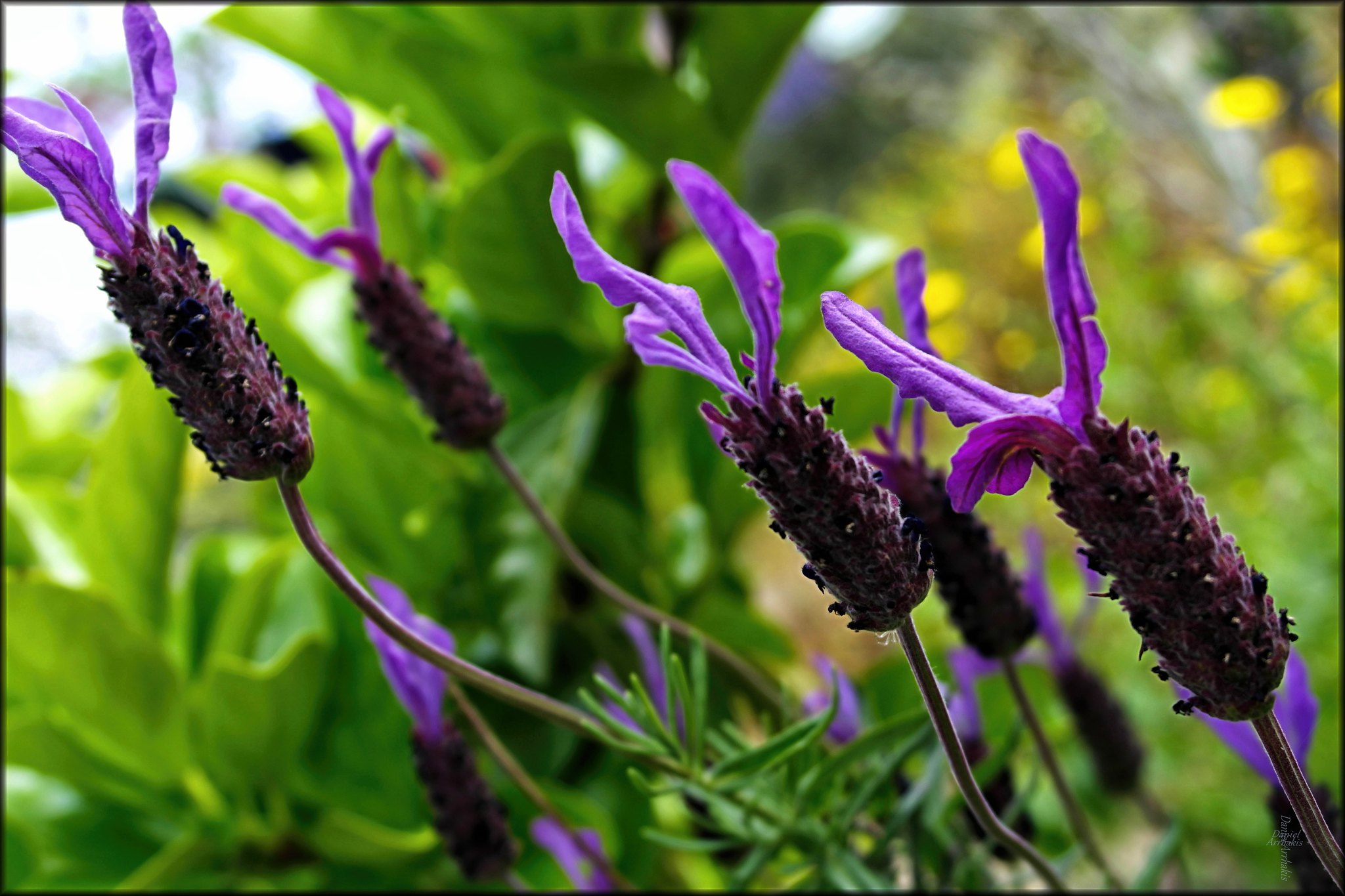
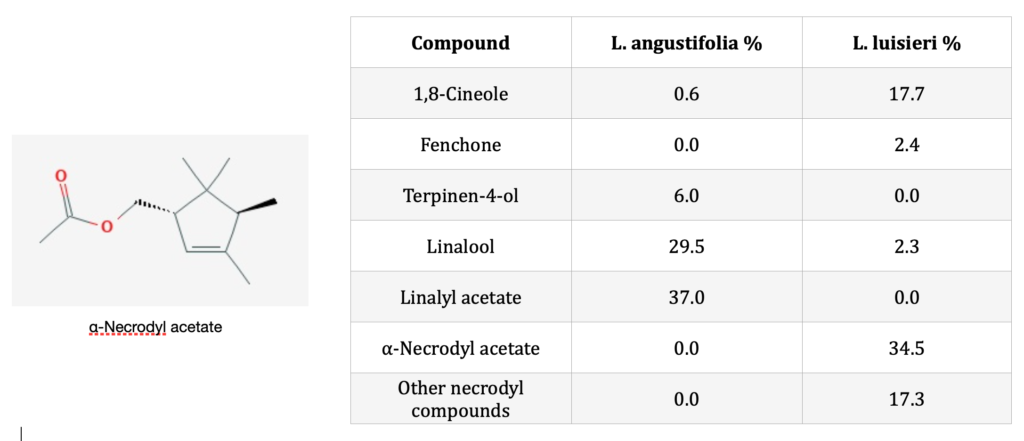
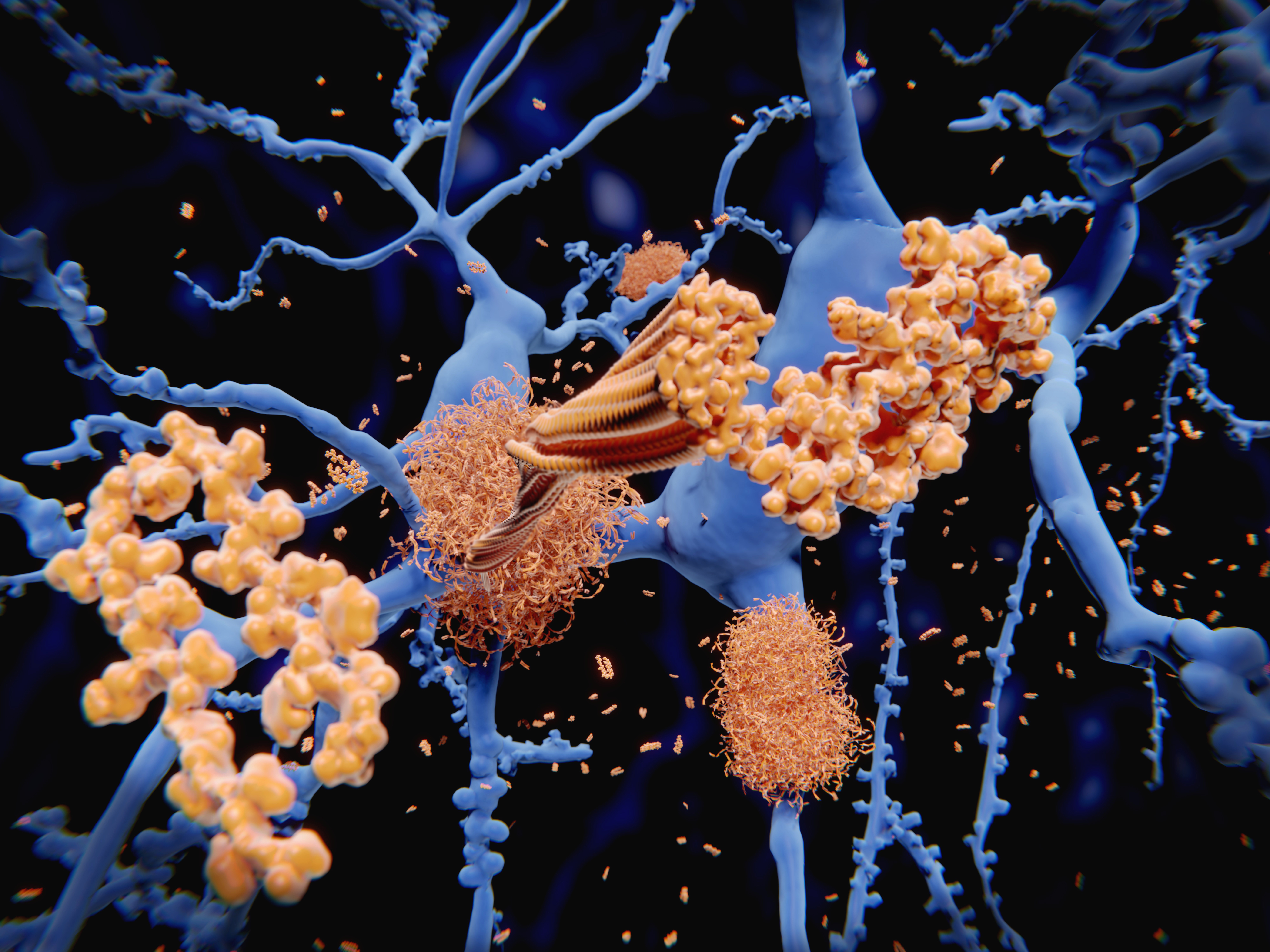

Very informative and interesting. I would like to try this oil. I have several family members with arthritis. Learning about oils has been the greatest journey of my life. Thank you for adding to it.
Thank you, Robert, for this very interesting article. I wasn’t familiar with seville lavender. i’m intrigued with its potential for ALLEVIATING arthritis symptoms. Do you know of any reputable sources for this oil? The only source I’ve been able to find is sadly out of stock indefinitely.
Hi Ruth, I’m glad you enjoyed the article, it’s a really interesting oil! unfortunately I can’t tell you about suppliers. Since we refer to medicinal uses on our website, we can’t be linked to any particular brands or suppliers.
I must say that the L. Stoechas, no longer have in Seville. The one that exists is in Extremadura. The Doñana park does not have it spontaneously. I did a research project on native aromatics in Andalusia between the years 2000 and 2010.
Thank you for letting us know Jose.
Thank you for this great article. It is so encouraging that some promise is shown here for alzheimer’s disease. will definitely look out for this eo.